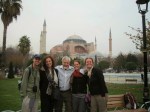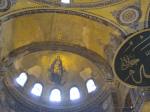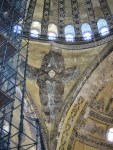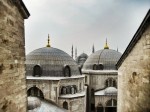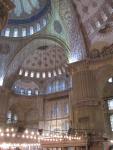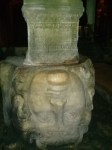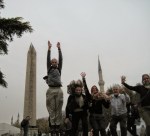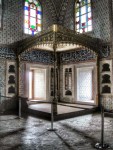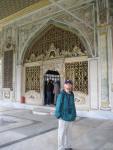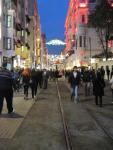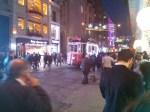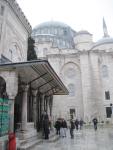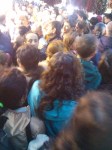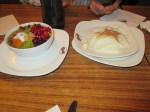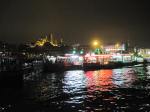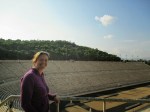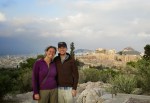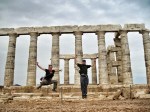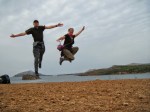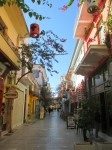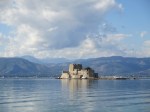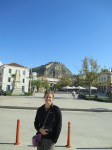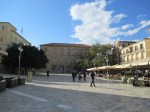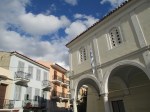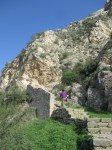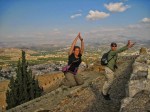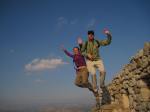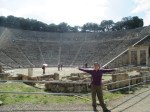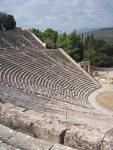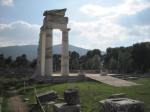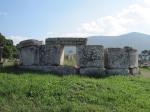Della’s family – her parents and her sister – joined us for two weeks in November as we traveled through Greece and Turkey. The first stop on our joint trip was Athens. We had already been in town on our own for a few days, but held off on the major sites until they arrived.
Getting There
We were already in town, but the others had a much longer journey to get to Athens. Della’s sister flew from California to Denver, and then the three of them flew from Denver to Houston, Houston to Paris and finally Paris to Athens. They arrived in the late afternoon. We were very happy to see them! But, after such a long travel day they were pretty exhausted!

Meeting each other in the metro station
Where We Stayed
With a group of five, we decided that a rental apartment was the best bet. It was a little tough finding a nice place for five on Airbnb, but we eventually found a good deal on HomeAway for a two bedroom apartment in the fancy Kolonaki neighborhood. The apartment we rented turned out to be quite fancy – it was clear that it was the primary residence of the older woman who owned the place. It was very nicely decorated so we were very careful not to mess anything up. There was some confusion about the large security deposit we paid, which made us wish for the simplicity of Airbnb.
-

-
The living room
-

-
The living room/study
-

-
Peggy enjoying the balcony
-

-
Reading at the dining table
What We Did
The Acropolis – We were itching to see this star attraction, so on our first full day we headed straight here. We decided to visit using the Rick Steves audio guide – the first time we attempted to listen to the narration instead of read it ourselves. Walking up through the columns of the Propylaea and onto the top of the hill was awe-inspiring. Even with the large amount of scaffolding covering the Parthenon, it was still very exciting to see the large temple in all its glory. The other highlight of the top was the back porch of the Erectheion with its six caryatid sculptures.
-

-
Temple of Athena Nike at the entrance
-
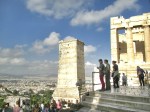
-
A monument pedestal in the Propylaea
-

-
Entering the Acropolis through the Propylaea
-

-
The Parthenon
-

-
The group in front of the east side of the Parthenon
-

-
Group jelfie on the west side of the Parthenon (plus passers-by…)
-
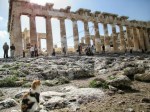
-
Parthenon cat
-

-
The porch with the caryatids on the Erechtheion
-
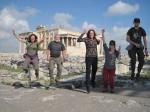
-
Family jelfie in Greece – seeing a place for the first time (Della, Eric, and Dana) and for the 2nd 35 years after the first (Peg and Wayne)
-

-
Wayne contemplating the view over the city
The Ancient Agora – After the Acropolis, we headed down the hill to the ruins of what was the main part of town during the heyday of ancient Athens. The most impressive ruin left is the Temple of Hephaestus, one of the best-preserved Doric temples. The rest of the agora was a mix of Greek and Roman stoas (covered markets) and statues. The site closed at 3 since it was the low season, so we didn’t get to spend as much time in the on-site museum as we would have liked.
-

-
The agora with the Temple of Hephaestus in the backgroun
-

-
The agora with the acropolis high above
-
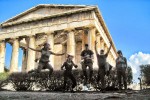
-
Temple of Hephaestus Jelfie
-

-
A modern art installation on display in the agora
-
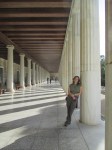
-
The columns of the Agora museum, housed in a building constructed to look like an ancient stoa
The Acropolis Museum – The Acropolis Museum is housed in a fancy new modern structure just south of the acropolis. It is built over the ruins of an ancient neighborhood, so various places in the floor have clear panels so you can see what is beneath. The museum has a large amount of space devoted to different items from the acropolis throughout ancient history, laid out in roughly chronological order. The ramp to the first level has ancient pottery. Then, during the Archaic Era, the predominant artifacts were the kore and korous statues. They did a good job of showing how colorful they must have once been.
For the main architectural elements of the classical era, they split the big items into rooms based on the structure they came from. This meant there was an area for the Temple of Athena Nike, an area for the Erectheion (showcasing the original caryatid statues) and then on the top floor all by itself, a large area for the Parthenon. There was also a video describing the decorations and layout of the Parthenon. The pediment, frieze and metopes are all laid out in the same order they would have been on the Parthenon, utilizing the entire floor which is of the same size. The museum is quite clear in multiple places that they would like the works of art that the British Museum “stole” back at this museum. The missing pieces are currently shown as ugly plaster casts.
-

-
The entrance to the Acropolis Museum
-

-
From the first level looking up
-

-
The caryatids from the Erectheion
-

-
From behind, you can see that the caryatids have different hair and clothing styles
-

-
The Parthenon level
-

-
The Parthenon level
-

-
After a long day of sightseeing, we enjoyed some tea at the museum cafe which has a great view of the Acropolis
The National Archaeological Museum –
At the museum, we again all plugged into the Rick Steves audio tour. The museum went in chronological order and was quite extensive. The first major area was the Cycladic figurines and other art, from the 3rd century BC. Then, they covered the findings from Mycenae. We were pretty excited to see the artifacts from Mycenae that we had heard about when at the site and from reading Greek Treasure.
-

-
Cycladic figurines
-

-
The “Mask of Agamemnon” from Mycenae
-

-
Minoan ceremonial cups
The next stop was the Archaic era, where we again learned more about the kore and kourous statues. The next major era was the Severe Style. The sculptures started to get more realistic, but the expressions were stern. The most classic piece from this era was a large bronze sculpture of either Zeus or Poseidon (we don’t know which because we can’t see if he is throwing a lightning bolt or trident).
-

-
A korous (male)
-

-
An Archaic korous
-

-
Zeus/Poseidon
For the classical era, many of the finds were split into different rooms. There was a large collection of rooms focused on the art found on tombstones in the ancient cemeteries. There were many elaborate marble carvings to be found. The sculpture of Paris was one of the highlights of this era.
-
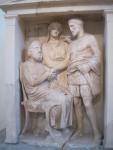
-
A funerary monument
-

-
Paris
The next period is the Hellenistic era, which was characterized by sculptures which more realistic faces (instead of idealized) and more active movements. Some of the highlights in the collection were the Jockey of Atemision and Aphrodite fighting off Pan with her shoe. The final period covered was the Roman era. Here they tried to copy the Greek styles and were somewhat successful, although the art was less impressive.
-

-
The Jockey of Arteision
-

-
Aphrodite fighting off Pan
-

-
Roman Emporer Augustus
This concluded the main part of the tour. There was still a little bit to be seen of the museum, so we split up and saw the parts we were interested in. There was an ancient “computer” which calculated various celestial phenomenon. We also looked through the bronze collection, Egyptian collection and ceramics collection.

The ancient computer
Rick Steves City Walk – We followed the Rick Steves walk of the main downtown area to get a feel for the more modern parts of Athens. The tour started at Syntagma Square, and we lucked out in our timing to see the hourly changing of the guard in front of the Parliament building. We then walked down Ermou, the main pedestrian shopping street. The second part of the tour focused on the Greek Orthodox church, so we passed by the main cathedral and a few other churches, plus some stores that sold Greek Orthodox icons. The highlight of the last part of the walk through the Plaka area was a trip through the small neighborhood of Anafiotika. It was built by residents of the island of Anafi, so it has that Greek island “feel” to it.
-

-
The changing of the guard in front of the Greek Parliament
-

-
Ermou Street
-

-
Greek Orthodox church jelfie
-

-
A statue of Greek Orthodox Archbishop Damaskinos
-

-
Byzantine Icons store
-
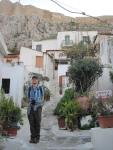
-
The Anafiotika neighborhood
-

-
The Anafiotika neighborhood
The Island of Aegina – One of Della’s dad’s priorities for the Greece portion of the trip was to make a trip to an island. We had read that Hydra was very nice, so we decided to make a day trip there on one of our days. We didn’t think we needed to stress about the ferry ticket, so we just showed up the morning of and went to buy our ticket… big mistake. They were sold out! We weren’t quite sure what to do, but the ticket agent suggested the nearby island of Aegina. We decided to just head there and ended up having a pleasant day. We wondered around the back streets, sampled some of the local pistachios and found a beach that we ended up having mostly to ourselves. The archaeological site was closed for renovations, which was a bummer, but we could still see the lone remaining column from the Temple of Apollo from our beach. We rounded out the day with a seafood meal sitting next to the ocean, then caught the ferry back into Athens.
-

-
Our “Flying Dolphin” ferry
-

-
Aegina Town
-

-
Exploring the back streets of town
-

-
The lone column remaining in the Temple of Apollo
-

-
Some of us were brave enough to swim…
-

-
… while others were content to bask in the sun
-
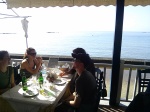
-
Eating a nice meal by the water
Where We Ate
The best restaurant we ate at by far was a little restaurant hidden away north of Omonia Square called Bread and Roses. The simple menu allowed you to choose a meat dish, a salad and a side (all homemade). Your choices were then prepared in the small kitchen just next to the seating area. The food was the best we had and the variety quite impressive as well (not your standard Greek taverna options). Highly recommended!

Final Thoughts
We finished up our four weeks in Greece with a whirlwind of activity once Della’s family arrived. The limited amount of time made us feel a little rushed, but we are definitely glad we made sure to see everything that we got to see.



